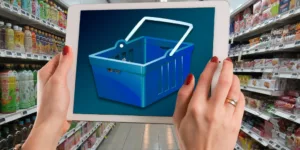Over the last 10 years, internet shopping has boomed. Pioneers of online retail including Tom Chapman, co-founder of Matchesfashion, Katia Beauchamp of Birchbox, and Tim Steiner, co-founder of Ocado, would no doubt approve.
But what’s next? What changes in online shopping will we see in 2019? Here are three things we could experience ourselves this year.
1. The rise of direct social commerce
Social commerce has been around since 2005, when the phrase was coined by the search engine Yahoo! But up until now, the term has only really been used to describe the way brands interact with their customers through social media. Last year that changed, and this year we’re set to see the pace of change increase.
Companies have become increasingly interested in new developments affecting the way consumers use and interact with photographs. In January, Marks and Spencer launched a new innovation that allows customers to upload an image of an outfit and use its Style Finder tool to look for similar outfits on their site.
Taking this one step further, hot on the heels of Pinterest’s Shop The Look innovation launched in September, in the last few days Instagram has announced a new feature that will allow users to buy what they see in photos directly from the app, without ever leaving the site. More than 20 fashion companies have signed up to sell via Instagram including big names such as Nike and Zara.
Snapchat has also recently got in on the act. Late last year they launched a new tool which enables users to scan a barcode or object using the app’s camera. Once scanned, the customer is shown a thumbnail of the product, or something similar, and can choose to be redirected to the product page on Amazon.
This innovation is sure to sweep quickly across all social platforms, if only because it’s another way to tackle the perennial problem of how to monetize social media.
2. Shopping without boundaries
Up until now, retailers have been focused on creating mobile and tablet apps, and have spent a great deal of time and money on developing an engaging online user experience. Many brands would now likely wish for a short period to regroup before turning their attention to the next innovation. Sadly for them it’s already here, and most are already behind the curve.
Shopping without boundaries is the next trend and the first wave is upon us. With the advent of improved speech-recognition technology and superior AI-powered chatbots, in-car shopping via embedded tech, for example, is becoming a reality.
People already shop regularly via their mobile while using public transport to commute. In the UK this amounts to almost £23bn spent per year on shopping while you travel. But I think everyone will agree that shopping while driving is a very different proposition, but one that makes perfect sense.
Driving is regarded by today’s commuters as wasted time, and because you’ve got your hands on the wheel you’re more likely to use the in-car voice applications and assistants. In fact, US data shows that more than 110m adults have used in-car voice assistants 77m use it on a monthly basis.
This year we’ll start to see the introduction of shopping-assistant technology built into cars as an optional extra, or maybe even as a standard feature in some of the top-range vehicles. Last year, BMW launched an integration with Amazon’s Alexa, so we’re on the cusp of this tech going mainstream.
3. Boom in same-day delivery
There has been a lot of talk about the boom in same-day delivery, but until very recently it was mostly speculation, with few retailers able to scale it up successfully. Drone deliveries have not expanded at the rate predicted and many consider drones to be at the wackier end of a list of sensible home-delivery options.
But where once we also scoffed at the idea of same-day delivery by robot, we’re starting to see this technology become a reality. Just last month, FedEx trailed its upcoming delivery vehicle, the FedEx SameDay Bot. Due to be piloted in Memphis city in the summer, the zero-emissions robot was developed in partnership with companies including Walmart and Pizzahut, so this is not a machine that will just deliver parcels.
Technology has allowed the development of smart robots that can see, analyse and learn. The FedEx bot is said to be able to navigate not just roads but pavements and stairs. What’s particularly interesting about this innovation is that it marks the start of the race to develop same-day solutions across the retail industry. When the largest couriers start developing robots you know that same-day delivery for everyone, no matter their location, is just around the corner.
These are just three of the most exciting changes we’re likely to see in online retail in 2019. There will be more on the horizon because retail is a sector that never stands still.








